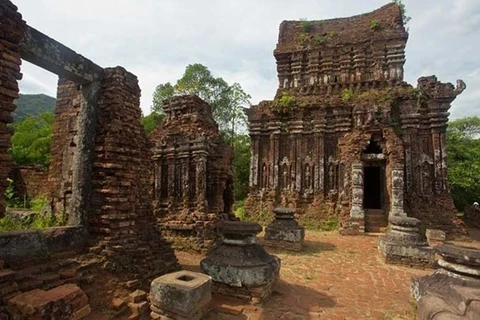 An overview of Nen Chua archeological site in Kien Giang province (Source: Institute of Imperial Citadel Studies)
An overview of Nen Chua archeological site in Kien Giang province (Source: Institute of Imperial Citadel Studies) Hanoi (VNA) – A large number of items have been excavated in the Oc Eo-Ba The and Nen Chua archeological relic sites, most of which are ceramics and glass jewelry.
After four years of implementing the Oc Eo cultural archeology project at the Oc Eo-Ba The and Nen Chua relic sites, researchers have found nearly 2.8 million artifacts, of which, more than 2.3 million artifacts were discovered at Oc Eo-Ba Chua site, and 414,446 archaeological artifacts found at Nen Chua site.
Among the discovered relics, two were recognised as National Treasures in late 2021. They are stone carved with a meditating Buddha image and a gold Nandin Giong Cat Ring.
On March 25, the Vietnam Academy of Social Sciences (VASS) announced the results of the project.
VSS President, Associate Prof. De. Bui Nhat Quang said that this is a large-scale scientific project that started in 2017. The aim was to collect evidence and clarify the history of formation and development of the Oc Eo culture and the Phu Nam (Funan) Kingdom. They also wanted to get a better understanding of the role and importance of the ancient area of Oc Eo in the history of Vietnam, Southeast Asia and Asia.
It also aims to provide a scientific basis for the planning, conservation and promotion of values as well as for the compiling of dossiers submitted to UNESCO to seek the recognition of Oc Eo-Ba The relic site as a world cultural heritage.
Excavation findings reveal that Oc Eo-Ba The was an urban area and an economic-cultural centre of the Oc Eo-Phu Nam culture. Nen Chua was an important port which handled exports and imports of the Oc Eo urban area and other localities in the Long Xuyen Quadrilateral Region in particular and the southwestern region in general.
In 1944, French archaeologist Louis Mallecet carried out excavations at the site, along with his colleagues from the French School of the Far East. They unearthed objects offering proof of a flourishing civilisation and well-developed trade with other areas in Southeast Asia.
People in the Phu Nam civilisation produced many handicrafts, including ceramics, and had the ability to refine copper, iron and tin, along with creating silver and gold jewelry.
Earlier, Deputy Prime Minister Vu Duc Dam has assigned the Ministry of Culture, Sport and Tourism to submit a brief report on the Oc Eo - Ba The relic site to the UNESCO World Heritage Centre, proposing putting the site on the Tentative List.
He assigned the People’s Committee of the Mekong Delta province of An Giang, where the relic site is located, to chair the process of building a dossier for the site.
The special national relic site of the ancient Oc Eo civilisation covers 433.2ha of land in Oc Eo township of Thoai Son district.
The Oc Eo civilisation, part of the ancient kingdom of Phu Nam, was first discovered by French archaeologist Louis Malleretin in 1942 via artefacts unearthed in the area of Ba The Mountain, now in Oc Eo township.
The civilisation, named after Mound Oc Eo in Thoai Son district where the relic site was first found, took shape and developed strongly in southern Vietnam between the first and seventh century.
Apart from Thoai Son, relics of the Oc Eo civillisation have also been found in other localities of An Giang province. There is a rich diversity of artefacts discovered so far, including those relating to religion, architecture, graves, and canals.
The Tentative List is an inventory of properties which States Parties consider to be cultural and/or natural heritage of outstanding universal value and therefore suitable for inscription on the World Heritage List./.
























